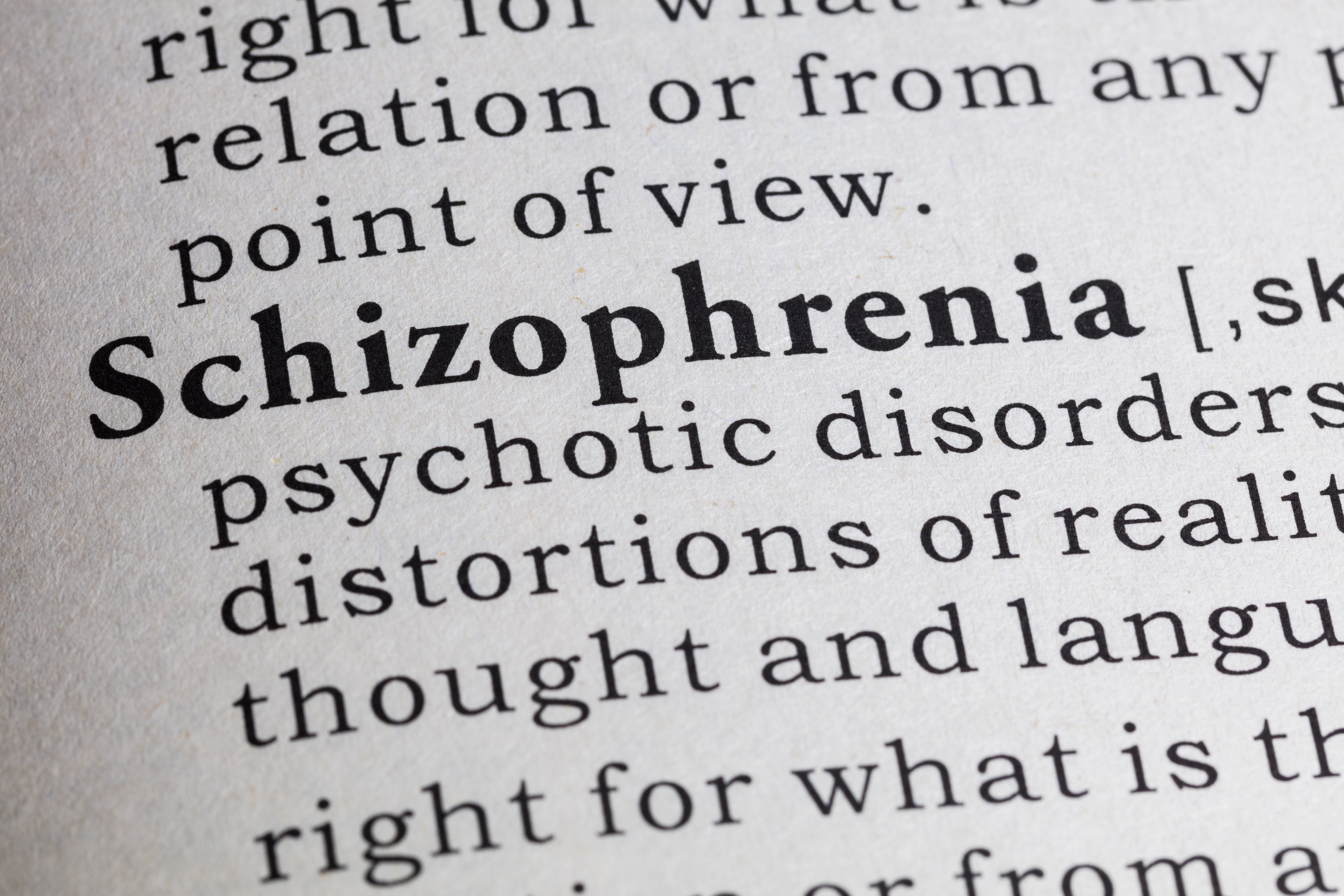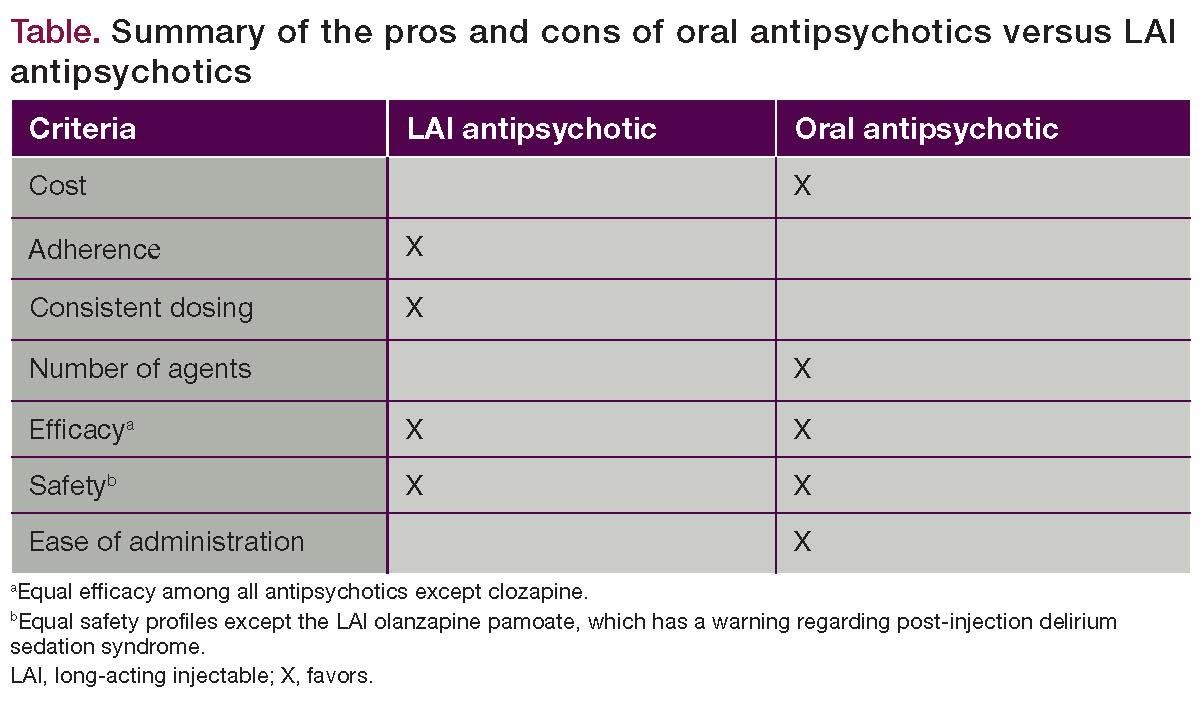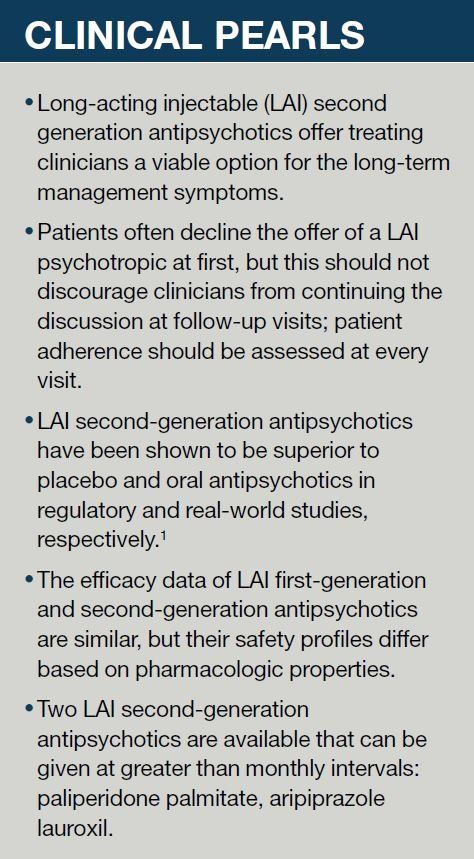Publication
Article
Psychiatric Times
Understanding Long-Acting Injectable Antipsychotics for Better Treatment Adherence
Author(s):
Patient nonadherence to long-term antipsychotic therapy presents clinicians with unique unmet needs but also opportunities for promoting the realistic benefits of consistent treatment.

Table. Summary of the pros and cons of oral antipsychotics versus LAI antipsychotics

Clinical Pearls

Listen to the podcast: The Buzz on Long-Acting Injectable Antipsychotics
Premiere Date: March 20, 2020
Expiration Date: September 20, 2021
This activity offers CE credits for:
1. Physicians (CME)
2. Other
All other clinicians either will receive a CME Attendance Certificate or may choose any of the types of CE credit being offered.
ACTIVITY GOAL
The goal of this activity is to provide an understanding of long-acting injectable antipsychotics and how they can benefit treatment adherence.
LEARNING OBJECTIVES
After engaging with the content of this CME activity, you should be better prepared to:
• Identify the formulation differences between oral and long-acting injectable (LAI) antipsychotics.
• Assess the efficacy and safety profiles of LAI second-generation antipsychotics.
• Discuss LAI antipsychotics as they relate to treatment adherence.
TARGET AUDIENCE
This continuing medical education (CME) activity is intended for psychiatrists, psychologists, primary care physicians, physician assistants, nurse practitioners, and other health care professionals who seek to improve their care for patients with mental health disorders.
ACCREDITATION/CREDIT DESIGNATION/FINANCIAL SUPPORT
This activity has been planned and implemented in accordance with the accreditation requirements and policies of the Accreditation Council for Continuing Medical Education (ACCME) through the joint providership Physicians’ Education Resource®, LLC and Psychiatric Times. Physicians’ Education Resource®, LLC is accredited by the ACCME to provide continuing medical education for physicians
Physicians’ Education Resource®, LLC designates this enduring material for a maximum of 1.5 AMA PRA Category 1 Credits™. Physicians should claim only the credit commensurate with the extent of their participation in the activity.
This activity is funded entirely by Physicians’ Education Resource®, LLC. No commercial support was received.
OFF-LABEL DISCLOSURE/DISCLAIMER
This CME activity may or may not discuss investigational, unapproved, or off-label use of drugs. Participants are advised to consult prescribing information for any products discussed. The information provided in this CME activity is for continuing medical education purposes only and is not meant to substitute for the independent clinical judgment of a physician relative to diagnostic or treatment options for a specific patient’s medical condition.
The opinions expressed in the content are solely those of the individual faculty members and do not reflect those of Physicians’ Education Resource®, LLC.
FACULTY, STAFF, AND PLANNERS’ DISCLOSURES
The author and the staff members of Physicians’ Education Resource®, LLC and Psychiatric Times have no relevant financial relationships with commercial interests.
John J. Miller, MD, external peer reviewer, reports that he is on the Speaker Bureaus for Sunovion, Otsuka, Allergan, Teva, Neurocrine, and Janssen; and he is on the Advisory Board for Janssen and Align2Action.
Eric Achtyes, external peer reviewer, reports that he has received research support from Alkermes, Astellas, Biogen, Boehringer-Ingelheim, Janssen, Neurocrine Biosciences, Otsuka, Pine Rest Foundation, Takeda, and Vaguard Research Group; and he has served as a consultant or on advisory boards for Alkermes, Indivior, Janssen, Neurocrine Biosciences, and Roche.
For content-related questions, email us at PTEditor@mmhgroup.com; for questions concerning the accreditation of this CME activity or how to claim credit, please contact info@gotoper.com and include Understanding Long-Acting Injectable Antipsychotics for Better Treatment Adherence in the subject line.
HOW TO CLAIM CREDIT
Once you have read the article, please use the following URL to evaluate and request credit https://education.gotoper.com/activity/ptcme20mar. If you do not already have an account with PER® you will be prompted to create one. You must have an account to evaluate and request credit for this activity.
Patient nonadherence to long-term antipsychotic therapy presents clinicians with unique unmet needs but also opportunities for promoting the realistic benefits of consistent treatment. According to the World Health Organization, adherence is defined as “the extent to which a person’s behavior-taking medication, following a special diet, and/or executing lifestyle changes, corresponds with agreed recommendations from a health care provider.” However, nonadherence typically implies a situation in which a patient cannot follow a specific medication regimen. Both adherence and nonadherence can be imprecise terms in a patient’s clinical management where the lack of a defined threshold exists. Clinicians who prescribe oral antipsychotics may overestimate adherence and underestimate nonadherence.
CASE VIGNETTE
“John” is a 24-year-old male who 6 months ago received a diagnosis of schizophrenia. After successful initial treatment with an oral antipsychotic, he felt no further need to take his medications. Subsequently, over the next several months, his family noticed that delusional symptoms began reappearing and withdrawal behaviors from current activities increased.
At his next outpatient appointment, the prospect of a long-acting injectable antipsychotic was introduced. Initially, John refused the injectable antipsychotic saying that he can take oral medications. Over the next 2 weeks, his family noticed that only part of his medication was taken and, when looking over the number of tablets, it appeared that John was taking about half of his medication. His clinician told him that if inconsistent adherence to treatment continues, the symptoms likely will not get better and could get worse. If the symptoms and his thinking get worse, he may need to be hospitalized.
The option of a LAI was reintroduced. Although John was seemingly reluctant, he was convinced by the treatment team and agreed to give the LAI a try for the next few months. His family whole-heartedly supported the LAI option knowing that this option would eliminate gaps in his pharmacotherapy.
Long-acting injectable (LAI) antipsychotics address both adherence and nonadherence issues. Fluphenazine enthate, a first-generation antipsychotic, became available as a LAI in the US in the 1960s; fluphenazine decanoate LAI became became available in the 1970s; and haloperidol decanoate LAI became available in the 1980s.
The first second-generation antipsychotic LAI, risperidone microsphere, was FDA approved in 2003. Only three other LAI second-generation antipsychotics are currently available: olanzapine pamoate, paliperidone palmitate, and aripiprazole (available as monohydrate and lauroxil formulations). Paliperidone palmitate has two formulations for monthly or three-month injection intervals. Aripiprazole lauroxil also has formulations that allows for monthly, a 6-week, or 8-week administration intervals.
Formulation, pharmacokinetics, and dosing
The process to develop LAI antipsychotic formulations represents significant technological challenges and opportunities. Based on their chemical structure, not all antipsychotics are available as a LAI formulation. LAI formulations impose their pharmacokinetic profiles, initial dosing requirements, storage conditions, and utilization methods as well as the ability to slowly release in the body over an extended time period.
LAI fluphenazine and haloperidol are basically esters that are dissolved in sesame oil. LAI second-generation antipsychotics are aqueous preparations with different formulations. Only risperidone microspheres are given at 2-week intervals; the other LAI second-generation antipsychotics are administered from monthly to as long as every 3 months (olanzapine pamoate microcrystals, paliperidone palmitate Nanocrystals, and two aripiprazole preparations: a lyophilized monohydrate and a prodrug approach with the N-acyloxymethyl molecule). These formulations account for their different pharmacokinetic profiles and dosing practices. The common thread is that the dosing interval is extended beyond daily oral dosing.
The key concept for LAI antipsychotics is that the time to reach steady-state conditions takes longer than an oral formulation as the drug is gradually released from the deltoid (also the gluteus maximus) muscle injection site. Because of this, oral antipsychotics are typically needed for about 2 to 3 weeks when LAIs are started. However, there are exceptions:
1) Paliperidone palmitate dosing starts at 234 mg followed by a 156 mg second administration one week later and reaching therapeutic plasma concentrations within a few days.
2) Olanzapine pamoate reaches peak plasma concentration 2 to 4 days after injection with an elimination half-life of 2 to 4 weeks.
3) Aripiprazole lauroxil has a 1-day treatment initiation option where the patient can receive a single 675-mg aripiprazole lauroxil injection plus 30-mg oral aripiprazole and, depending on individual patient’s needs, a dose of 441 mg, 662 mg, or 882 mg administered monthly, 882 mg administered every 6 weeks or 1064 mg administered every 2 months.
After initiation, LAI antipsychotics can be administered monthly or every 4 weeks. Paliperidone palmitate can be given every 3 months, but only after the patient has been stabilized with the monthly formulation for at least 4 months-with the last two injections at the same dose. Monthly LAI aripiprazole lauroxil has two additional formulations with administration every 6 or 8 weeks.
To provide further dosing flexibility for patients and providers, LAI antipsychotics can be administered +/- 1 week for the monthly dosing intervals allowing for possible changes in the patient’s appointment schedule. This also applies to the 3-month paliperidone palmitate preparation with a +/- 2-weeks for the every 3-months dosage schedule. (For more information on dosing, missed doses, and switching strategies see Samtani et al.2 and Magnisson et al.3)
Summary of clinical studies
There is a large body of clinical studies on LAI second-generation antipsychotics including those leading to regulatory agency approval as well as real-world studies. The latter study types provide clinicians with a comprehensive look at various clinical situations.
LAI second-generation antipsychotics are FDA approved for the acute and/or maintenance treatment of schizophrenia. The LAI formulations have several additional indications: monthly paliperidone palmitate is FDA approved for schizoaffective disorder; risperidone and aripiprazole monohydrate are FDA approved for bipolar disorder.
Clinical studies designed for regulatory agency review typically follow a specific design methodology. For example, patients are randomly assigned to a placebo control group and compared to one or more doses of the antipsychotic. LAI antipsychotic doses are usually fixed doses to accurately determine the drug’s efficacy and safety profiles. The study duration for acute exacerbation of schizophrenia is about 12 weeks. The primary efficacy outcome measure uses the Positive and Negative Syndrome Scale (PANSS) where the total score decreases from baseline to the study endpoint and demonstrates a statistical significance from the placebo group.
The study design for a maintenance study with a LAI antipsychotic is more complex with two main phases in a trial: an open-label phase and a double-blind phase. At a minimum, the open-label phase consists of different stages where patients are switched to the LAI formulation of the antipsychotic being studies, and then to a tolerability phase. The next step is being stabilized on either the oral formulation or directly to a LAI antipsychotic (plus an oral dosing overlap if needed). The subsequent stage proceeds with LAI administration with the study agent with continued stabilization. These stages can last from 9 weeks up to 36 weeks depending on study design. Finally, LAI second-generation antipsychotics are evaluated in a 52-week, double-blind, and placebo control phase.
The primary outcome measure is the time for patient relapse. In the monthly paliperidone palmitate study, relapse was defined as hospitalization, an increase in total PANSS or an increase on any specified PANSS item (eg, delusions) for two consecutive assessments, and deliberate self-injury or aggressive behavior and suicidal or homicidal ideation deemed significant by the clinician.4
For the 400 mg aripiprazole monthly dose study, the primary outcome was time to relapse of psychotic symptoms and/or impending relapse defined as any or all 4 criteria on the Clinical Global Impression Scale (CGIS), risk of suicide as defined by the CGIS, an increase on any individual PANSS item (eg, hallucinatory behavior), hospitalization, or violent behavior.5
The study design was similar for the 3-month paliperidone palmitate preparation; however, the trial consisted of the monthly formulation (transitional phase) followed by one injection of the 3-month formulation (maintenance phase), and finally the double-blind, placebo-controlled phase.6 The primary outcome was relapse where relapse rates and time to first relapse were calculated. Relapse was defined as hospitalization, an increase level of care, an increase of 25% in the total PANSS score, or an increase of 10 points if the baseline total PANSS was less than 40. Clinical situations such as deliberate self-injury, suicidal or homicidal ideations, violent behavior or property damage, or a change in the CGIS score to 6 or 7 were also included in the relapse criteria.
These complex study designs are necessary to establish objective and subjective patient stability prior to the testing conducted in the double-blind, placebo-control phase. Therefore, when a relapse episode takes place, its occurrence is defined and scored by a binary process (eg, yes/no).
Each of the studies with monthly LAI second-generation antipsychotics showed efficacy. Patients had significantly fewer (P < .05) relapse and hospitalization rates. LAI antipsychotics with a longer than monthly administration interval have unique qualities when undergoing efficacy analysis. The 3-month paliperidone palmitate clinical trial interim analysis for delaying time to relapse was significantly in favor of the active agent compared with placebo (P < .001) with the median time to relapse of 274 days. The relapse rate for 3-month paliperidone palmitate compared with placebo group was substantially lower (9% versus 29%, respectively).
LAI first-generation versus second-generation
LAI risperidone was not available to providers until 2003. Yet, the question of comparing a first-generation antipsychotics with a second-generation antipsychotic presented clinicians with an intriguing issue. For example, how to design a study that can equally compare a first-generation to a second-generation antipsychotics. A double-blind clinical study (funded by Janssen, the manufacturer of risperidone) evaluated oral risperidone (mean [± SD] dose 4.9 ± 1.9 mg) versus oral haloperidol (mean dose 11.7 ± 5.0 mg).6 The study was undertaken to examine relapse prevention in outpatients with schizophrenia or schizoaffective disorder (N = 397) with an extensive criteria defined for relapse. The results indicated a higher relapse rate for haloperidol (risk ratio = 1.93, 95% CI = 1.33 – 2.80, P < .001) versus risperidone.
Another study compared LAI risperidone with a psychiatrist’s choice of oral antipsychotics in unstable schizophrenia or schizoaffective disorder.7 A total of 382 patients were enrolled in the study and randomized to receive LAI risperidone or continue on their oral antipsychotic. The findings indicate that LAI risperidone was not superior to the oral antipsychotics in preventing hospitalizations rates (39% after 10.8 months versus 45% after 11.3 months (respectively), hazard ratio (HR) = 0.87, 95% CI = 0.63 - 1.20). Moreover, there were no significant differences in survival and health service use.
The ACLAIMS clinical trial compared 1-month paliperidone palmitate with haloperidol decanoate in patients with schizophrenia or schizoaffective disorder.8 The primary criteria for efficacy failure included psychiatric hospitalization, need for crisis stabilization, increased frequency of outpatient visits, ongoing or repeated need for adjunctive oral antipsychotic medications, and several other reasons regarding transitioning from previous oral to injectable antipsychotics. No statistically significant differences between 1-month paliperidone palmitate and haloperidol decanoate in efficacy failure (HR = 0.98, 95% C.I. = 0.65 – 1.47) were found, which indicates that the antipsychotics were equally effective in preventing relapse.
Taken together, the results of these comparative studies of first-generation versus second-generation antipsychotics are reasonable given their pharmacologic profiles for dopamine receptor subtype 2 antagonism. The addition of serotonin 5-HT2A antagonism for risperidone and paliperidone is representative of most second-generation antipsychotics.
Examining and comparing safety profiles
The overall outcomes from the LAI second-generation antipsychotics studies found no new concerns regarding safety information. The only exception where a LAI second-generation antipsychotic differs in the safety profile from its oral counterpart is olanzapine pamoate. Approved by the FDA in 2009, olanzapine pamoate has a warning regarding post-injection delirium sedation syndrome, which occurs when the drug is inadvertently administered into a blood vessel, which leads to rapid drug release. The resulting symptoms are delirium, ataxia, confusion, or altered consciousness, thus the FDA requires that patients remain at their treatment facility for 3 hours post-injection.
For second-generation LAI antipsychotic usage, after establishing tolerability with the corresponding oral antipsychotic, the long-term safety monitoring should be ascertained using recommended guidelines where available. Providers should exercise their clinical assessments balancing benefits versus risk especially when LAI second-generation antipsychotics are prescribed. (For detailed information on adverse effects, the reader is referred elsewhere.9)
When treating with LAI second-generation antipsychotic, long-term monitoring is needed for metabolic syndrome, extrapyramidal effects (especially tardive dyskinesia), and hyperprolactinemia. For metabolic syndrome guidelines include monitoring of weight, fasting blood glucose, Hb1Ac, and lipid profiles at various treatment intervals.10
Findings suggest a relatively low occurrence of akathisia with LAI second-generation compared with LAI first generation antipsychotics. The incidence of akathisia was significantly greater for haloperidol decanoate compared with once-monthly paliperidone palmitate (10.6% versus 2.8% respectively, P = .006).8 The incidence was comparable to that of LAI aripiprazole lauroxil.11
A baseline Abnormal Involuntary Movement Scale (AIMS) exam is recommended before any antipsychotic medication is initiated; it should be repeated at least every 6 months with first-generation antipsychotics and annually with second-generation antipsychotics. Another safety difference reported in the clinical trial between haloperidol decanoate and 1-month paliperidone palmitate was the elevation of prolactin concentrations, but the incidence of sexual adverse effects, galactorrhea, and gynecomastia was not different.8
There were significant differences in serum prolactin concentrations (mean, 95% CI) between haloperidol decanoate and 1-month paliperidone palmitate in men (15.41 μg/L, 10.73 - 20.08 versus 34.56 μg/L, 29.75 - 39.37; respectively, P < .001) and women (26.84 μg/L, 13.29 - 40.40 versus 75.19 μg/L, 63.03 - 87.36; respectively, P < .001). However, no clinical significant differences were found on sexual dysfunction scores (≥ 19) using the Arizona Sexual Experiences scale in men (39.4% versus 37.8%; respectively, P = .77) and women (73.1% versus 72.7%; respectively, P = .88).
Elevated prolactin levels are known to occur with risperidone and paliperidone, but the long-term consequences remain to be elucidated. Prolactin levels remain relatively neutral with aripiprazole.
Communication strategies and considerations
Theoretically, any patient needing long-term maintenance antipsychotic treatment is a candidate for LAI antipsychotics. A pro and con summary of antipsychotics versus oral antipsychotics is presented in the Table, which can help when discussing treatment decisions with patients. LAI second-generation antipsychotics are typically more expensive than oral antipsychotics.
The Case Vignette describes the initial challenges for treatment providers and the need to collaborate with the patient in offering a LAI antipsychotic. LAI second-generation antipsychotics are preferred over first-generation antipsychotics because of fewer extrapyramidal adverse effects.12 There are advantages for LAI antipsychotics because the clinician has reliable information on how much medication was given during treatment. Moreover, patient adherence with oral antipsychotics can be overestimated and nonadherence underestimated by providers and caregivers.
Patients should be asked about adherence at every visit in a respectful manner without placing blame on any missed doses. Patients often decline the first opportunity for LAI antipsychotics. This should not discourage providers, the treatment team, or family caregivers. Over time, understanding and respecting the reasons for a patient’s nonadherence assists in building trust with the patient and his or her family or caregivers. Although, there are no guarantees with LAI antipsychotics about adherence- the patient may miss an appointment-clinicians have time to work with the patient on adherence.
After establishing initial tolerability with an oral antipsychotic that is available in a LAI preparation, the patient can be successfully transitioned. The efficacy of LAI antipsychotics are at least as comparable to the oral antipsychotics. Recent real-world designed large studies comparing LAI antipsychotics to oral antipsychotics demonstrated superiority of the injectable medications in preventing hospitalizations or relapse.1,13
Summary
LAI antipsychotics have been available to providers for more than 40 years yet they appears to be underutilized. LAI second-generation antipsychotics have been well-studied in clinical situations and in regulatory trials their adverse effects are well understood. LAI antipsychotics offer providers a viable option to help with medication adherence and reduce any potential gaps in treatment.
CME POST-TEST
Posttest, credit request forms, and activity evaluations must be completed online at https://education.gotoper.com/activity/ptcme20mar (requires free account activation), and participants can print their certificate or statement of credit immediately (80% pass rate required). This website supports all browsers. For PER’s privacy policy, please visit https://www.gotoper.com/privacy.
PLEASE NOTE THAT THE POSTTEST IS AVAILABLE ONLINE ONLY ON THE 20TH OF THE MONTH OF ACTIVITY ISSUE AND FOR 18 MONTHS AFTER.
Need Additional CME Credit?
Check Out These Free CME Activities Before They Expire
Psychocardiology, Part 2: Fixing the Broken Heart
Angelos Halaris, MD
Expiration Date: April 20, 2020
Medical Aid in Dying: Ethical and Practical Issues for Psychiatrists
Dan Nguyen, MD and Joel Yager, MD
Expiration Date: June 20, 2020
Suicide Risk and Sleep: What’s the Link?
Christopher W. Drapeau, PhD
Expiration Date: May 20, 2020
Substance Use Disorders in Crisis Settings: Engagement, Assessment, and Intervention Approaches
Kenneth Minkoff, MD
Expiration Date: July 20, 2020
Disclosures:
Dr Jann is Professor, Department of Pharmacotherapy, University of North Texas, System College of Pharmacy, UNT Health Sciences Center, Fort Worth, TX; he is the founder of Jann Medical Writing, LLC.
References:
1. Tiihonen J, Mittendorfer-Rut E, Majak M, et al. Real-world effectiveness of antipsychotic treatments in a nationwide cohort of 29,823 patients with schizophrenia. JAMA Psychiatry. 2017;74:686-693.
2. Samtani MN, Gopal S, Gassmann-Mayer C, et al. Dosing and switching strategies for paliperidone palmitate: based on population pharmacokinetic modeling and clinical trial data. CNS Drugs. 2011;25:829-845.
3. Magnusson MO, Samtani MN, Plan EL, et al. Dosing and switching strategies for paliperidone palmitate 3-month formulation in paitents with schizophrenia based population pharmacokinetics. CNS Drugs. 2017;31:273-288.
4. Hough D, Gopal S, Vijapurkar U, et al. Paliperidone palmitate maintenance treatment in delaying the time-to-relapse in patients with schizophrenia: a randomized, double-blind, placebo-controlled study. Schizophr Res. 2010;116:107-117.
5. Kane JM, Sanchez R, Perry PP, et al. Aripiprazole intramuscular depot as maintenance treatment in patients with schizophrenia: a 52-week, multicenter, randomized, double-blind, placebo-controlled study. J Clin Psychiatry. 2012;73:617-624.
6. Csernansky JG, Mahmoud R, Brenner R, for the Risperidone-USA-79 Study Group. A comparison of risperidone and haloperidol for the prevention of relapse in patients with schizophrenia. N Engl J Med. 2002;346:16-22.
7. Rosenheck RA, Krystal JH, Lew R, et al. Long-acting risperidone and oral antipsychotics in unstable schizophrenia. N Engl J Med. 2011;364:842-851.
8. McEvoy JP, Byerly M, Hamer RM, et al. Effectiveness of paliperidone palmitate vs haloperidol decanoate for maintenance treatment of schizophrenia. JAMA. 2104;311:1978-1986.
9. Jann MW, Kennedy WK. Safety and tolerability of antipsychotics. In Spina E, Trifiro G, Eds. Pharmacovigilance in Psychiatry. Switzerland: Springer International Publishing; 2016:167-189.
10. American Diabetes Association, American Psychiatric Association, American Association of Clinical Endocrinologists. Consensus development conference on antipsychotics drugs, and obesity and diabetes. Diabetes Care. 2004;27:596-601.
11. Naber D, Hansen K, Forray C, et al. Qualify: a randomized head-to-head study of aripiprazole and paliperidone palmitate in the treatment of schizophrenia. Schizophr Res. 2015;168:498-504.
12. Hasan A, Falkai P, Wobrock T, et al. World Federation of Societies of Biological Psychiatry guidelines for the biological treatment of schizophrenia, part 1: update 2012 on the acute treatment of schizophrenia and the management of treatment resistance. World J Biol Psychiatry. 2012;13:318-378.
13. Alphs L, Benson C, Cheshire-Kinney K, et al. Real-world outcomes of paliperidone palmitate compared to daily oral antipsychotic therapy in schizophrenia: a randomized, open-label, review board-blinded 15 month study. J Clin Psychiatry. 2015;76:554-561.







